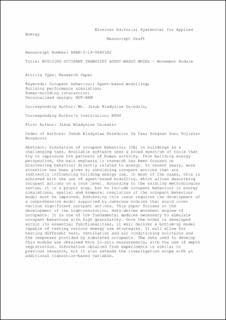| dc.contributor.author | Dziedzic, Jakub Wladyslaw | |
| dc.contributor.author | Yan, Da | |
| dc.contributor.author | Sun, Hongsan | |
| dc.contributor.author | Novakovic, Vojislav | |
| dc.date.accessioned | 2021-05-28T08:25:08Z | |
| dc.date.available | 2021-05-28T08:25:08Z | |
| dc.date.created | 2020-10-26T15:27:58Z | |
| dc.date.issued | 2020 | |
| dc.identifier.citation | Applied Energy. 2020, 261 . | en_US |
| dc.identifier.issn | 0306-2619 | |
| dc.identifier.uri | https://hdl.handle.net/11250/2756795 | |
| dc.description.abstract | Simulation of occupant behaviour (OB) in buildings is a challenging task. Available software uses a broad spectrum of tools that try to reproduce the patterns of human activity. From building energy perspective, the main emphasis in research has been focused on discovering behaviour directly related to energy. In recent years, more attention has been given to simulating occupant actions that are indirectly influencing building energy use. In most of the cases, this is achieved with the use of agent-based modelling which allows describing occupant actions on a room level. According to the existing methodologies review, it is a proper step, but to include occupant behaviour in energy simulations, spatial and temporal resolution of the occupant behaviour model must be improved. Addressing this issue requires the development of a comprehensive model supported by numerous modules that would cover various significant occupant actions. This paper focuses on the development of the high-resolution, data-driven movement engine of occupants. It is one of the fundamental modules necessary to simulate occupant behaviour with high granularity. Once the model is developed within its essential functionalities, it will deliver a bottom-up model capable of testing various energy use strategies. It will allow for testing different heat, ventilation and air conditioning solutions and the responses provided by simulated occupants. The data used to develop this module was obtained thru in-situ measurements, with the use of depth registration. Information obtained from experiments is similar to previous research, but it also extends the investigation scope with an additional transition-based variable. | en_US |
| dc.language.iso | eng | en_US |
| dc.publisher | Elsevier | en_US |
| dc.rights | Attribution-NonCommercial-NoDerivatives 4.0 Internasjonal | * |
| dc.rights.uri | http://creativecommons.org/licenses/by-nc-nd/4.0/deed.no | * |
| dc.title | Building occupant transient agent-based model – Movement module | en_US |
| dc.type | Journal article | en_US |
| dc.type | Peer reviewed | en_US |
| dc.description.version | acceptedVersion | en_US |
| dc.source.pagenumber | 13 | en_US |
| dc.source.volume | 261 | en_US |
| dc.source.journal | Applied Energy | en_US |
| dc.identifier.doi | 10.1016/j.apenergy.2019.114417 | |
| dc.identifier.cristin | 1842398 | |
| dc.description.localcode | Publisher embargo applies until March 1, 2022, © 2021. This accepted version is made available under the CC-BY-NC-ND 4.0 license http://creativecommons.org/licenses/by-nc-nd/4.0/ | en_US |
| cristin.ispublished | true | |
| cristin.fulltext | postprint | |
| cristin.qualitycode | 1 | |

